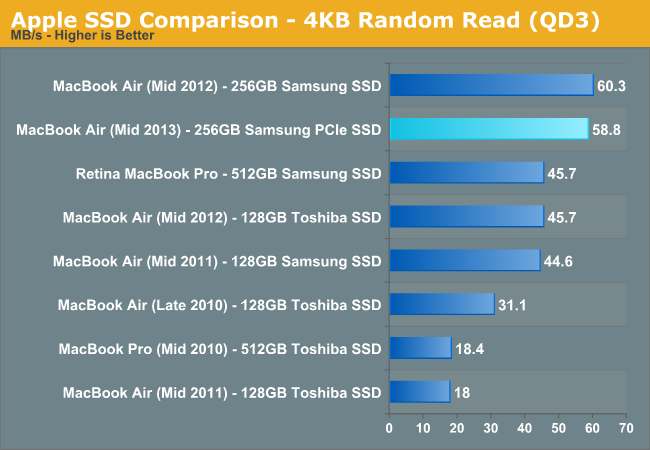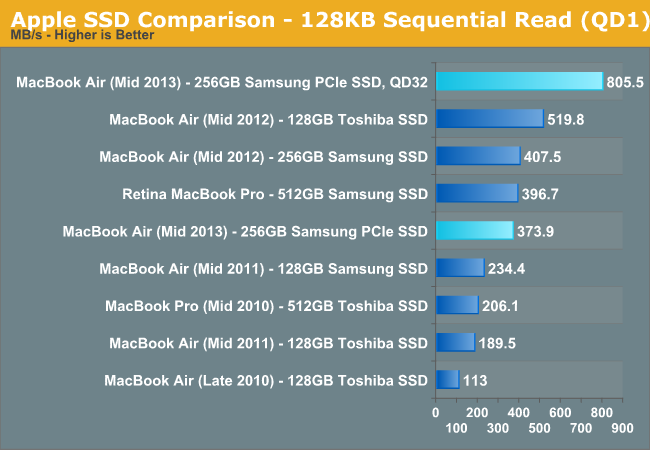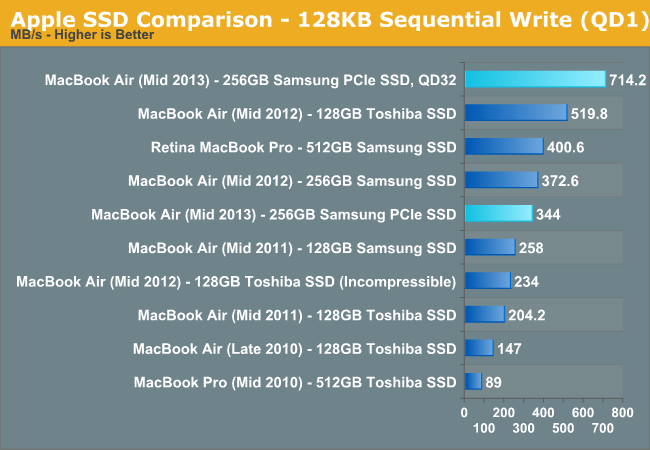The 2013 MacBook Air Review (13-inch)
by Anand Lal Shimpi on June 24, 2013 12:01 AM ESTPCIe SSD Performance
I created a Boot Camp partition of around 120GB and ran our client iometer benchmarks to put the new PCIe SSD’s performance in perspective.
Peak random read performance is roughly comparable to the previous-generation Samsung controller. Random write performance took a bit of a hit but it's still more than fast enough for client workloads. Sequential speeds are much improved but the gains are really only visible at high queue depths. Low queue depth sequential transfers can’t be split up enough in order to really require PCIe.




What does this mean in the real world? The new SSD is definitely snappier in system use. Wake from sleep is a bit quicker, as are application launches. The funny thing is that with the exception of high-speed Thunderbolt arrays, most external sources aren’t fast enough to even stress the new storage subsystem in the MacBook Air. Large file copies confined to the drive itself benefit a bit as well. I saw roughly 300MB/s reads and 300MB/s writes when copying a large dmg from/to the MacBook Air’s PCIe SSD (compared to roughly 200/200MBps on the old Samsung SATA SSD from the rMBP15).
If you have an external Thunderbolt array with at least a couple of drives, you should have no issues matching the MBA’s internal SSD performance.
Seeing as how this is our first experience with Samsung’s PCIe SSD controller, I wanted to get a feel for how the drive behaved under extended high queue depth random writes. I ran a modified version of our IO consistency test. The test was modified to run in a 91GB space on the MBA’s Boot Camp partition. I made sure to fill the rest of the drive completely, but the random writes were effectively constrained to 91GB of LBAs. When I get back from the UK I’m going to try setting up an external boot drive and will do some more extensive testing on the drive.
The IO consistency results, at least within a somewhat constrained space actually look really good. I have a feeling that Samsung might have improved its IO consistency story with this generation, but I’ll wait on saying for sure until I’ve had a chance to do some more work with the controller. For the vast majority of users however, solid random write performance like this over a 91GB space on a full drive is actually very good news.













233 Comments
View All Comments
spronkey - Monday, June 24, 2013 - link
Hmm. Very interested to see the CPU and battery life numbers for the i7 upgrade. If it manages to increase performance by 10% or so, and decrease battery life 10% or so, it could be a nice sweet spot.Bkord123 - Tuesday, June 25, 2013 - link
I can't wait for the i7 review. I think it's the once I'm leaning toward getting.timmyj9 - Monday, June 24, 2013 - link
i would be curious to know if the same 802.11ac file sharing bottlenecks occur when using NFS as the file sharing protocol?Kevin G - Monday, June 24, 2013 - link
It would as the tweak to resolve it was made to TCP and modern NFS are built on top of that.Khato - Monday, June 24, 2013 - link
Can't agree more that Haswell battery life is already blurring the lines with current tablets. I'm curious how the 2013 Tablet Bench Web Browsing suite compares specifically to the one used on notebooks? In the details provided in this review the specific frequency of web page loading is specified while it's not in the Tablet version.The iPad 4 with it's 42.5Wh battery and 9.48 hours of run-time in the test draws an average of 4.48W. If that test is comparable to the Light version shown here then you have the Haswell Macbook Air drawing an average of 4.9W, while if it's comparable to the Medium version then the average is 6.05W. Either way, when you consider that the Macbook Air's 13.3" diagonal screen has 1.88x more surface area than the iPad 4 (nit is another term for cd/m^2, so total luminous intensity of a 13.3" screen at 200 nits is 1.88x that of a 9.7" screen at 200 nits) it's pretty much a given that display power for the Macbook Air is higher than for the iPad 4 despite the lower resolution. Pretty cool.
Shivansps - Monday, June 24, 2013 - link
The HD5000 is running on single channel right? there is a 2do slot for another memory?Kevin G - Monday, June 24, 2013 - link
The entire SoC has dual channel memory. The MacBook Air has no memory expansion slots. If you want to get one of these, be sure to order with the amount of memory you think you'd need in the future.Shivansps - Monday, June 24, 2013 - link
Im saying that because of the IGP performance, i cant find any confirmation on the review that the MBA is running on dual channel memory, 4GB LPDDR3 sounds like 64 bit single channel to me, and that will impact IGP performance, even HD3000 has reduced 3D performance if not running on dual channel.Glindon - Monday, June 24, 2013 - link
Every Macbook Air that I've owned ran in dual channel mode. Why would this year's be any different.Kevin G - Monday, June 24, 2013 - link
Note the part in this article referring to the LPDDR3. It indicates that it has four 32 bit LPDDR3 packages which indicate a 128 bit wide bus (dual channel).